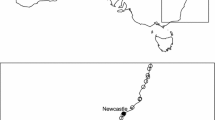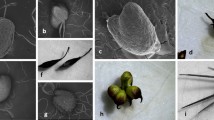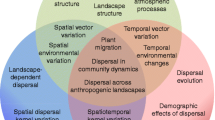Abstract
Reduced dispersability of species living on islands relative to mainland has been documented in both plants and animals. One evolutionary scenario explains this trend by strong selection against dispersal, once the species has reached the island, to reduce dispersal out to sea. In this study, we compare the dispersal ability of three wind dispersed plant species (Cirsium arvense, Epilobium angustifolium, and E. hirsutum) from populations on mainland and three islands. Dispersal ability was estimated directly as drop time of diaspores, and indirectly using a morphological measure relating the weight of the diaspore to the size of the pappus (Cirsium) or seed hairs (Epilobium). Positive correlation between the morphological measure of dispersal ability and drop time of diaspores were found for all study species. Dispersal ability varied significantly among mainland and islands, and among species. C. arvense showed a significant reduction in dispersal ability on islands compared to mainland, whereas the reverse was found for the two Epilobium species. Overall Epilobium diaspores had a 2–4 times higher dispersability than C. arvense, indicating that degree of isolation of islands vary among study species. Significant differences in dispersability among plants within populations were detected in all species suggesting that this trait may have a genetic component.
Similar content being viewed by others
References
Aaris-Sørensen K (1998) Danmarks forhistoriske dyreverden. Gyldendal, Kbh. Denmark
Acosta FJ, Delgado JA, Lopez F and Serrano JM (1997). Functional features and ontogenetic changes in reproductive allocation and partitioning strategies of plant modules. Pl Ecol 132: 71–76
Andersen MC (1992). An analysis of variability in seed settling velocities of several wind-dispersed Asteraceae. Amer J Bot 79: 1087–1091
Augspurger CK (1986). Morphology and dispersal potential of wind dispersed diaspores of neotropical trees. Amer J Bot 73: 353–363
Baker GA and O’Dowd DJ (1982). Effects of parent plant density on the production of achene types in the annual Hypochoeris glabra. J Ecol 70: 201–215
Burrows FM (1975) Wind-borne seed and fruit movement. New Phytol 75: 405–418
Carlquist S (1974) Island biology. NY: Columbia Univ. Press, 660p
Cody ML and Overton JM (1996). Short-term evolution of reduced dispersal in island plant populations. J Ecol 84: 53–61
Donohue K (1999). Seed dispersal as a maternally influenced character: mechanistic basis of maternal effects and selection on maternal characters in an annual plant. Amer Naturalist 154: 674–689
Donohue K, Schmitt J (1998) Maternal environmental effects in plants: adaptative plasticity? In: Mousseau TA, Fox CW (eds) Maternal effects as adaptations. Oxford University Press, pp 137–158
Green DS (1980). The terminal velocity and dispersal of spinning samaras. Amer J Bot 67: 1218–1224
Greene DF, Johnson EA (1989) A model of wind disperal of winged or plumed seeds. Ecology 70: 339–347
Higgins SI, Richardson M (1999) Predicting plant migration rates in a changing world: the role of long-distance dispersal. Amer Naturalist 153: 464–475. not found in the text
Howe HF and Smallwood J (1982). Ecology of seed dispersal. Annual Rev Evol Ecol Syst 13: 201–228
Hughes L, Dunlop M, French K, Leishman MR, Rice B, Rodgerson L and Westoby M (1994). Predicting dispersal spectra: a minimal set of hypotheses based on plant attributes. J Ecol 82: 933–950
Imbert E and Ronce O (2001). Phenotypic plasticity for dispersal ability in the seed heteromorphic Crepis sancta (Asteraceae). Oikos 93: 126–134
Levin SA, Muller-Landau HC, Nathan R and Chave J (2003). The ecology and evolution of seed dispersal: a theoretical perspective. Annual Rev Ecol Evol Syst 34: 575–604
Lynch M, Walsh B (1998) Genetics and analysis of quantitative traits. Sinauer Associates Inc. Sunderland, Massachusetts, USA
Matlack GR (1987). Diaspore size, shape and fall behaviour in wind-dispersed plant species. Amer J Bot 74: 1150–1160
Meyer SE and Carlson SL (2001). Achene mass variation in Ericameria naussosus (Asteraceae) in relation to dispersal ability and seedling fitness. Funct Ecol 15: 274–281
Olivieri I, Michalakis Y and Gouyon P-H (1995). Metapopulation genetics and the evolution of dispersal. Amer Naturalist 146: 202–228
Pedersen L, Fischer A, Aaby B (1997) Storebælt i 10.000 år. Mennesket, havet og skoven: A/S Storebæltsforbindelsen, Denmark
Peroni PA (1994). Seed size and dispersal potential of Acer rubrum (Aceraceae) samaras produced by populations in early and late successional environments. Amer J Bot 81: 1428–1434
Riba M, Mignot A, Fréville H, Colas B, Imbert E, Vile D, Virevaire M and Olivieri I (2005). Variation in dispersal traits in a narrow-endemmic plant species, Centaurea corymbosa Pourret. (Asteraceae). Evol Ecol 19: 241–254
Ronce O, Brachet S, Olivieri I, Gouyon P-H and Clobert J (2005). Plastic changes in seed dispersal along ecological succession: theoretical predictions from an evolutionary model. J Ecol 93: 431–440
Salisbury E (1976). Seed output and the efficacy of dispersal by wind. Proc Roy Soc London Series B 192: 323–329
SAS Institute Inc. (1999) JMP Users Guide, 3rd edn., Cary, North Carolina, USA
Sheldon JC and Burrows FM (1973). The dispersal effectiveness of the achene-pappus units of selected compositae in steady winds with convection. New Phytol 72: 665–675
Author information
Authors and Affiliations
Corresponding author
Rights and permissions
About this article
Cite this article
Fresnillo, B., Ehlers, B.K. Variation in dispersability among mainland and island populations of three wind dispersed plant species. Plant Syst Evol 270, 243–255 (2008). https://doi.org/10.1007/s00606-007-0615-1
Received:
Accepted:
Published:
Issue Date:
DOI: https://doi.org/10.1007/s00606-007-0615-1




